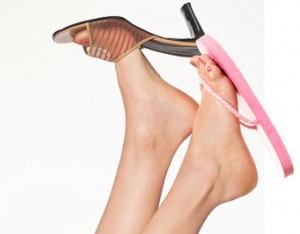What is worse for your feet, high heels or flip flops? Sandals or stilettos? Did you read this article in the Daily Mail today? www.dailymail.co.uk
“Our physiotherapists get asked daily about which shoes are best” says Laura Harman, Specialist BOOST PHYSIOTHERAPIST. In this article we list the BOOST physiotherapist’s opinions FOR and AGAINST flip flops and high heels (and no we are not talking fashion).
We have also designed 2 exercises to counteract some of the ill effects of flip flops, by Jolene Sher, Clinic Manager at Hendon.
FOR Flip Flops
- Allows stretching of the achilles tendon
- Exercises some of the intrinsic muscles in the feet
- Some believe that walking barefoot or with minimal arch-support strengthens the feet
- For those who have walked barefoot most of their life, flip flops will protect the soles of feet from hot surfaces and sharp objects
AGAINST Flip Flops
- Those who have worn shoes most of their life have developed muscles, ligaments and joints that rely on the structured support from shoes
- Lack of support for the calcaneus (heel bone)
- Lack of lateral foot support enabling ankle sprains more easily
- Flat sole can cause achilles tendonitis and plantar fascitis
- Shorter stride length when walking
- Increased clawing of toes to grip on the flip flop
- Those who have gown up wearing shoes have had muscles, ligaments and joints that rely on the structured support in shoes
FOR High Heels
- Heeled shoes reduce stretch and strain on the achilles tendons
- Heels help maintain the arch of the foot
- Strengthens some of the ankle muscles
- High heels stimulate balance receptors in the ankles
AGAINST High Heels
- Bunions and hammer toes!
- Increases the arch in the lower back which causes stress
- Leads to shortened, tight calf muscles
- Increased pressure at the ball of the foot, can be linked with Morton’s Neuroma
- Pressure under the knee caps
- Increased risk of ankle sprains and falls
If you are reading this blog you have probably been wearing shoes since being a 1 year old. We wear shoes to protect our feet from thorns, stones, glass, hot pavements or cold snow. We as shoe wearing people have become adapted to wearing shoes.
Our feet, ankles and knees have become accustomed to the support that the bones and joints of the feet and ankles receive from our shoes. So to spend long periods of time wearing shoes that offer little or no support to the feet and ankles, is a recipe for trouble.
What is clear is that every shoe has its time and place, from football boots, to flip flops and sneakers to stilettos.
2 Key exercises to help fight ill effects of flip flops:
1) I call this one “The Cowboy” and it helps to strengthen the calf muscle called soleus and the achilles tendon. This muscle is often underpowered and under used.
Begin the exercise in “The Cowboy” stance.
Lift up onto your tip toes slowly for 3 counts, stay up for 3 counts and lower for 3 counts.
Begin with 10 repetitions, 2 sets with a 1min break between.
Build up to 20 repetitions, 3 sets with 1min break between.
